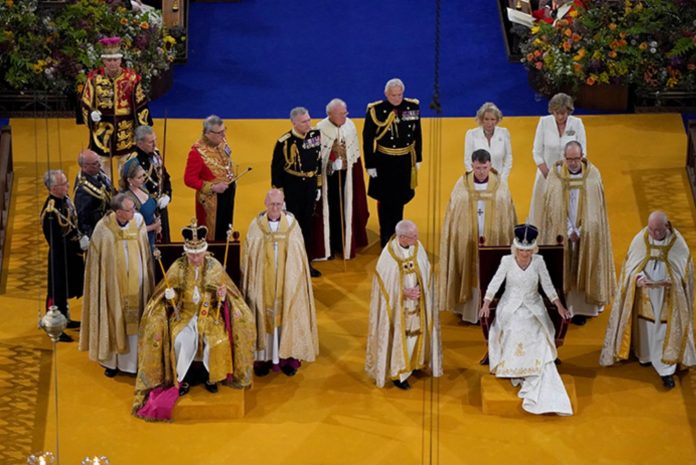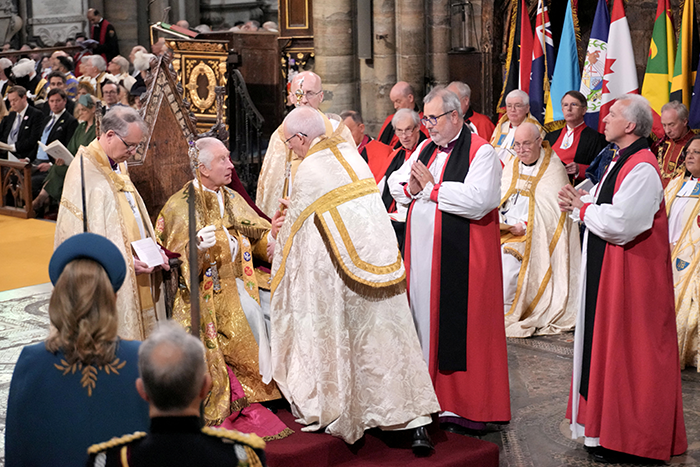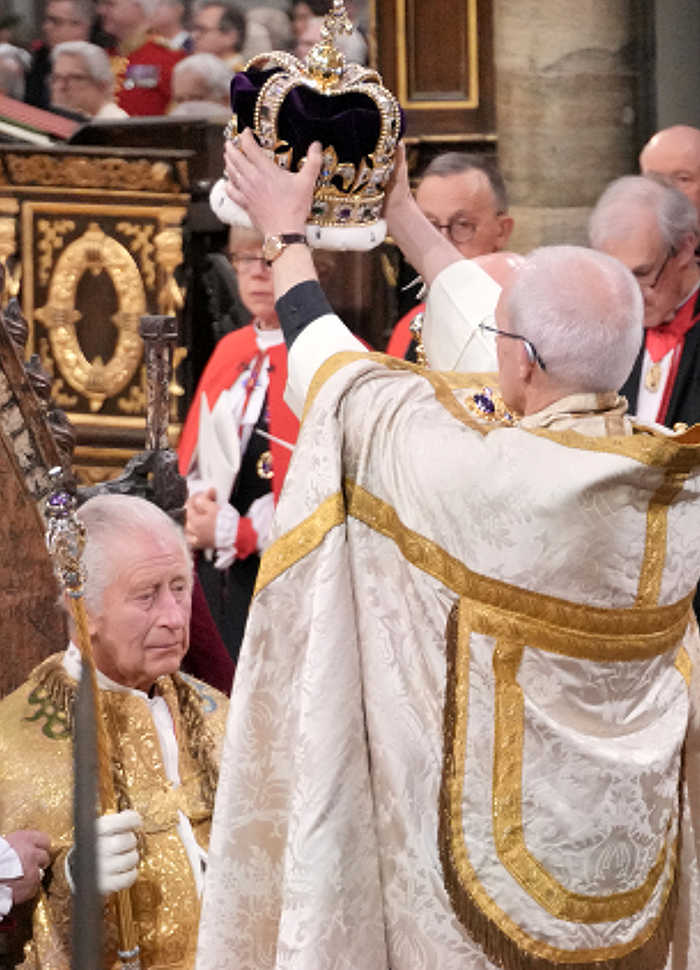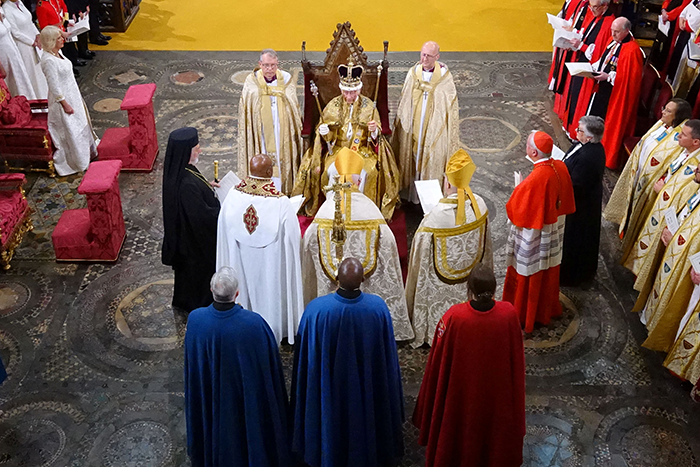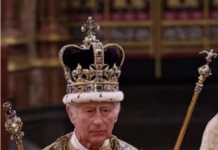The Anglican Archbishop in Jerusalem joined Anglican primates from every corner of the British Isles on Saturday for the coronation of His Majesty King Charles III at Westminster Abbey. Nine bishops from the Church of England also took part in the liturgy, which was described by a spokesman for Lambeth Palace as “a Christian act of worship that honours the ancient tradition of anointing and crowning Monarchs.
The Archbishop of Canterbury, Justin Welby, led the service, which was set in the context of a Eucharist. In his sermon, which reflected the theme “Called to Serve”.
“We are here to crown a King, and we crown a King to serve”, Archbishop Justin said. “What is given today is for the gain of all. For Jesus Christ announced a Kingdom in which the poor and oppressed are freed from the chains of injustice. The blind see. The bruised and broken-hearted are healed.
“That Kingdom sets the aims of all righteous government, all authority. And the Kingdom also sets the means of all government and authority. For Jesus doesn’t grasp power or hold onto status.
“The King of Kings, Jesus Christ, was anointed not to be served, but to serve. He creates the unchangeable law of good authority that with the privilege of power comes the duty to serve.
“Service is love in action. We see active love in our care for the most vulnerable, the way we nurture and encourage the young, in the conservation of the natural world. We have seen those priorities in the life of duty lived by our King.”
The Anglican Archbishop in Jerusalem, the Most Revd Dr Hosam Naoum, presented the chrism oil for anointing to Archbishop Justin. The oil was made from olives taken from trees growing in two monasteries on the Mount of Olives in Jerusalem. The oil was blended and co-consecrated by the Patriarch of Jerusalem, His Beatitude Theophilus III and Archbishop Hosam.
The King was anointed on his head, hands and breast in a sacred moment shielded from public view.
After this, various regalia and items from the collection of Crown Jewels were symbolically presented to the King.
King Charles III during his coronation ceremony in Westminster Abbey, London.
Photo: Jonathan Brady/Pool/REUTERS
The Anglican Archbishop of Armagh, Archbishop John McDowell, Primate of All Ireland, presented the Orb to the Archbishop Justin, who placed it in the King’s right hand. “Receive this Orb, set under the Cross, and remember always the kingdoms of this world are become the kingdoms of our Lord, and of his Christ.”
The Orb was made in the 1600s and is representative of the Sovereign’s power. It symbolises the world under the cross of Christ. It is divided into three sections with bands of jewels, for each of the three continents that were thought to exist in the time it was made.
A glove and ring were then presented, after which the Archbishop of Wales, Bishop of Bangor Archbishop Andy John, and the Primus of Scotland, Bishop of Moray, Ross & Caithness, Bishop Mark Strange, presented the Sceptre and Rod to Archbishop Justin, who gave them to the King, saying: “Receive the Royal Sceptre, the ensign of kingly power and justice; and the Rod of equity and mercy, a symbol of covenant and peace. May the Spirit of the Lord which anointed Jesus at his baptism, so anoint you this day, that you might exercise authority with wisdom, and direct your counsels with grace; that by your service and ministry to all your people, justice and mercy may be seen in all the earth: through the same Jesus Christ our Lord. Amen.”
The Sceptre with Cross represents the Sovereign’s temporal power and authority. It is associated with good governance, which is to be exercised wisely. The Sceptre with Dove, traditionally known as ‘the Rod of Equity and Mercy’, represents the Sovereign’s spiritual role, with the enamelled dove with outspread wings representing the Holy Spirit, and the Monarch’s pastoral care for the People.”
King Charles III receives The St Edward’s Crown during his coronation ceremony in Westminster Abbey, London.
Photo: Jonathan Brady/Pool/REUTERS
The Dean of Westminster Abbey then handed the Crown of Saint Edward to Archbishop Justin who prayed a prayer of blessing over it: “King of kings and Lord of lords, bless, we beseech thee, this Crown, and so sanctify thy servant Charles upon whose head this day thou dost place it for a sign of royal majesty, that he may be crowned with thy gracious favour and filled with abundant grace and all princely virtues; through Jesus Christ our Lord, who with thee and the Holy Spirit liveth and reigneth, supreme over all things, one God, world without end. Amen.”
The Crown of Saint Edward was made in 1661 for the coronation of Charles II. It replaced the medieval crown thought to date back to King Edward the Confessor – later to become Saint Edward the Confessor – who built Westminster Abbey. Saint Edward died at the Battle of Hastings in 1066. That original crown was melted down in 1649 after the Parliamentarians won the English Civil War, temporarily ending monarchical rule.
Leaders from other Christian Churches in the UK, including Archbishop Angaelos, the Coptic Orthodox Church of Alexandria’s Archbishop of London and Co-Chair of the official Anglican-Oriental Orthodox International Commission (AOOIC); and the Roman Catholic Archbishop of Westminster, Cardinal Vincent Nichols, joined the Archbishops of Canterbury and York, Justin Welby and Stephen Cottrell, in praying a blessing over the newly-crowned King.
King Charles III after being crowned with St Edward’s Crown by The Archbishop of Canterbury the Most Reverend Justin Welby during his coronation ceremony in Westminster Abbey, London
Photo: Aaron Chown/Pool/REUTERS
Attention then turned to Queen Camilla, who was crowned as Queen Consort with the Crown of Queen Mary.
The Bishops of Hereford and Norwich, Bishop Richard Jackson and Bishop Graham Usher – a member of the Anglican Consultative Council – served as Bishop Assistants to Queen Camilla; while the Bishops of Bath and Wells and Durham, Bishop Michael Beasley – a co-convenor of the Anglican Health and Community Network – and Bishop Paul Butler served as Bishop Assistants to King Charles.
The Patten and Chalice were carried in the procession by the Bishops of Dover and Chelmsford, Bishop Rose Hudson-Wilkin and Bishop Guli Francis-Dehqani.
Also taking part in the service was the Bishop of London and Dean of His Majesty’s Chapels Royal, Bishop Sarah Mullally; the Bishop of Worcester and Lord High Almoner, Bishop John Inge; the Bishop of Carlisle and Clerk of the Closet, Bishop James Newcome; and the Archbishop of York and Primate of England, Archbishop Stephen Cottrell.
In addition to being Head of State of the United Kingdom of Great Britain and Northern Ireland, King Charles is also the monarch of 14 other Realms: Antigua and Barbuda, Australia Bahamas, Belize, Canada, Grenada, Jamaica, New Zealand, Papua New Guinea, Saint Kitts and Nevis, Saint Lucia, Saint Vincent and the Grenadines, Solomon Islands, and Tuvalu. Prime Ministers from all 15 Realms were present in the Abbey for the coronation, alongside kings, queens and members of other royal families around the world, other heads of state and government, military figures, charity workers, Christian leaders from other denominations and leaders of other faith communities present in the UK.

